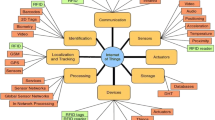Abstract
Sink mobility brings new challenges to data dissemination in large sensor networks. It suggests that information about each mobile sink’s location be continuously propagated throughout the sensor field in order to keep all sensors informed of the direction of forwarding future data reports. Unfortunately, frequent location updates from multiple sinks can lead to both excessive drain of sensors’ limited battery supply and increased collisions in wireless transmissions. In this paper, we describe TTDD, a Two-Tier Data Dissemination approach that provides scalable and efficient data delivery to multiple, mobile sinks. Each data source in TTDD proactively constructs a grid structure, which enables mobile sinks to continuously receive data on the move by flooding queries within a local cell only. TTDD’s design exploits the fact that sensors are stationary and location-aware to construct and maintain the grid infrastructure with low overhead. We evaluate TTDD through both analysis and extensive simulations. Our results show that TTDD handles sink mobility effectively with performance comparable with that of stationary sinks.
Similar content being viewed by others
References
J. Albowicz, A. Chen and L. Zhang, Recursive position estimation in sensor networks, in: Proceedings of ICNP’01 (2001).
S. Basagni, Distributed clustering for ad hoc networks, in: Proceedings of International Symposium on Parallel Architectures, Algorithms, and Networks (I-SPAN’99) (1999).
D. Braginsky and D. Estrin, Rumor routing algorithm for sensor networks, in: Proceedings of Workshop on Sensor Networks and Applications (WSNA) (2002).
A. Cerpa, J. Elson, D. Estrin, L. Girod, M. Hamilton and J. Zhao, Habitat monitoring: Application driver for wireless communications technology, in: Proceedings of ACM SIGCOMM Workshop on Data Communications in Latin America and Caribbean (2001).
D. Coffin, D.V. Hook, S. McGarry and S. Kolek, Declarative ad-hoc sensor networking, in: Proceedings of SPIE Integrated Command Environments (2000).
G. Finn, Routing and addressing problems in large metropolitan-scale internetworks, Technical Report ISI/RR-87-180, Information Sciences Institute (March 1987).
Z. Fu, P. Zerfos, H. Luo, S. Lu, L. Zhang and M. Gerla, The impact of multihop wireless channel on TCP throughput and loss, in: Proceedings of International Annual Joint Conference of the IEEE Computer and Communications Societies (INFOCOM’03) (2003).
W. Heinzelman, J. Kulik and H. Balakrishnan, Adaptive protocols for information dissemination in wireless sensor networks, in: Proceedings of ACM International Conference on Mobile Computing and Networking (MOBICOM’99) (1999).
J. Hightower and G. Borriello, Location systems for ubiquitous computing, IEEE Computer Magazine 34(8) (2001) 57–66.
J. Hill, R. Szewczyk, A. Woo, S. Hollar, D. Culler and K. Pister, System architecture directions for networked sensors, in: Proceedings of International Conference on Architectural Support for Programming Languages and Operating Systems (ASPLOS-IX) (2000).
C. Intanagonwiwat, R. Govindan and D. Estrin, Directed diffusion: A scalable and robust communication paradigm for sensor networks, in: Proceedings of ACM International Conference on Mobile Computing and Networking (MOBICOM’00) (2000).
B. Karp and H. Kung, GPSR: Greedy perimeter stateless routing for wireless networks, in: Proceedings of ACM International Conference on Mobile Computing and Networking (MOBICOM’00) (2000).
C. Lin and M. Gerla, Adaptive clustering for mobile wireless networks, IEEE Journal on Selected Areas in Communications 15(7) (1997) 1265–1275.
A.B. McDonald, A mobility-based framework for adaptive clustering in wireless ad-hoc networks, IEEE Journal on Selected Areas in Communications 17(8) (1999).
G. Pottie and W. Kaiser, Wireless integrated network sensors, Communications of the ACM 43(5) (2000) 51–58.
R. Sivakumar, P. Sinha and V. Bharghavan, CEDAR: A core-extraction distributed ad hoc routing algorithm, IEEE Journal on Selected Areas in Communications, Special Issue on Ad Hoc Networks 17(8) (1999).
D. Waitzman, C. Partridge and S. Deering, Distance vector multicast routing protocol, RFC 1075 (1988).
A. Ward, A. Jones and A. Hopper, A new location technique for the active office, IEEE Personal Communications 4(5) (1997) 42–47.
Y. Xu, J. Heidemann and D. Estrin, Geography informed energy conservation for ad hoc routing, in: Proceedings of ACM International Conference on Mobile Computing and Networking (MOBICOM’01) (2001).
F. Ye, S. Lu and L. Zhang, GRAdient Broadcast: A robust, long-lived large sensor network (2001), http://irl.cs.ucla.edu/papers/grab-tech-report.ps
Y. Yu, R. Govindan and D. Estrin, Geographical and energy aware routing: A recursive data dissemination protocol for wireless sensor networks, Technical Report UCLA/CSD-TR-01-0023, UCLA Computer Science Department (May 2001).
Author information
Authors and Affiliations
Corresponding author
Rights and permissions
About this article
Cite this article
Luo, H., Ye, F., Cheng, J. et al. TTDD: Two-Tier Data Dissemination in Large-Scale Wireless Sensor Networks. Wireless Netw 11, 161–175 (2005). https://doi.org/10.1007/s11276-004-4753-x
Issue Date:
DOI: https://doi.org/10.1007/s11276-004-4753-x




